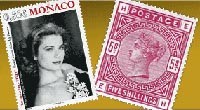Stamps:
Here are some interesting (to me anyway) facts about stamps and stamp collecting...
1. Depending on how you measure things, stamp collecting is the...
most popular collectable -figured by Google and based on web-sites, blogs etc.
most popular & BEST thing to collect -according to the USPS (!?!)
2nd most popular thing to collect -behind coin collecting
3rd most popular thing to collect -accordibng to the Department of Labor's Statistical Abstract
2. The first stamp issued was the Penny Black in England, in 1840, showing young Queen Victoria
3. The first American stamp was issued in 1847, cost five cents, and was good for a letter going up to 300 miles. Had a picture of Benjamin Franklin -the first US Postmaster General -appointed in 1775 by the Continental Congress.
4. Collecting and philately are different. A philatelist study stamps and may or may not collect them, while a collector may collect-up a bunch of them 'cause they are pretty and go no further. But as I was to learn, most of each are also the other, know what I mean?
5. Some stamps are pretty dang valuable. To whit:
This is the most valuable stamp. The plane is upside down. A bunch were printed in 1918 and when the mistake was discovered, they destroyed all of them All of then except 100 that made it out. Worth between $20,000 and $525,000 -depending on cancelation and who you talk to.
No, THIS is the most valuable stamp. It's an 1856 British Guiana One Cent Black on Magenta. It's valuable because the mail-boat from England was late, (some things never change do they?), and the local post-master couldn't wait. He had a small batch of them run up to tide them over. Only one survives. Changed hands for $935,000 in 1980.
Or maybe this one is. It's the Treskilling Yellow (Swedish 'three shillings'), issued in 1855 and accidently printed in yellow instead of green. Supposedly worth $2.5 million Swiss Francs.
It's fun to play the What-Iz-Worth game, but worth is pretty subjective. I studied it all carefully in my article Collecting for Profit, and learned interesting things about prices and particularly about stamps. But I have to say, I'm impressed with the history (and legend !) that surrounds these stamps. These people know their stuff. Most Collectors are also philatelist of the highest order. In addition, they know their history and geography. Think about it for a minute, stamps serve to get things from here to there -no matter where here or there are. Here could be Paris and there could be an island in Tahiti. Pretty romantic. Even more so when dates get stirred in. Take Tahiti -if the stamp was post-marked the same time Paul Gauguin was there painting (from 1891 till his death in 1903), it is just a little more interesting.
I have a final comment on stamps and stamp collecting. I quote my own-dang-self from my article on Children & Collecting:
We teacher-types do all sorts of things to get our students motivated / prepared / willing / awake enough etc. to learn. Collecting is a wonderful -pain-free way to do this. Consider, for example, stamp collecting and geography. A child who has somehow gotten a stamp from Timbuktu just has to wonder where Timbuktu is. If there a gazetteer and / or a big map of the world somewhere in the home, education HAS to follow. One small word of caution though, there is a fine line between helping a child learn and irritating the little dear beyond all tolerance. You don't need to be an expert in a given subject or collectable to teach your kids. Let them follow their own interests.
Preservation of Stamps.
Like numismatics, (collecting money -particularly paper money), the stamp collector MUST be knowledgeable about dyes, inks, and the effect light may have on them. Most stamp collections are tucked away safely in little archival-safe envelopes in one or more notebooks. This is as it should be, but what about displaying just one or two stamps. First thing to come to mind is a Riker-mount. But they have glass, and glass is not opaque to UV radiation, and UV is the most damaging light there is, particularly to dyes & inks. One of my shadow boxes would be better given that they are made with acrylic windows and acrylic is opaque to UV. Check out Advanced Shadow Boxing to learn how to absolutely show-case small items.
Interesting Stamp Collecting Links:
 You probably already know about the American Philatelic Society. If not it IS the place to start.
You probably already know about the American Philatelic Society. If not it IS the place to start.

Now this is interesting. Imagine having an envelope postmarked Pearl Harbor, December the 7, 1941 (it was a Sunday actually, so maybe the 6th or 8th), or New York, September 11, 2001? I'll just let the Postmark Collectors Club say it for themselves:
The Post Mark Collectors Club (PMCC) is an International Organization commited to the preservation of postal history and encouraging the fun and interesting hobby of Post Mark collecting. The club is a non-profit affiliate of the American Philatelic Society. With over 35,000 named Post Offices in the U.S. and many more around the world, the collecting potential is limitless.
It looks to me as if Herrick Stamp Co. has just about ALL the stamps in the world. A little commercial but attractive and well organized lay-out.
Stamp Link is a wonderfull sprawling mess of a site, but it's made by folks that clearly know and LOVE their subject.
The Virtual Stamp Club is another commercial site, but one that is more into thehopbbythen profit -LOTS of interesting and usefull stuiff.
![]() StampListing.Com is a philately web portal dedicated to the world wide stamp collectors. Pretty commercial, but also pretty all-inclusive.
StampListing.Com is a philately web portal dedicated to the world wide stamp collectors. Pretty commercial, but also pretty all-inclusive.

